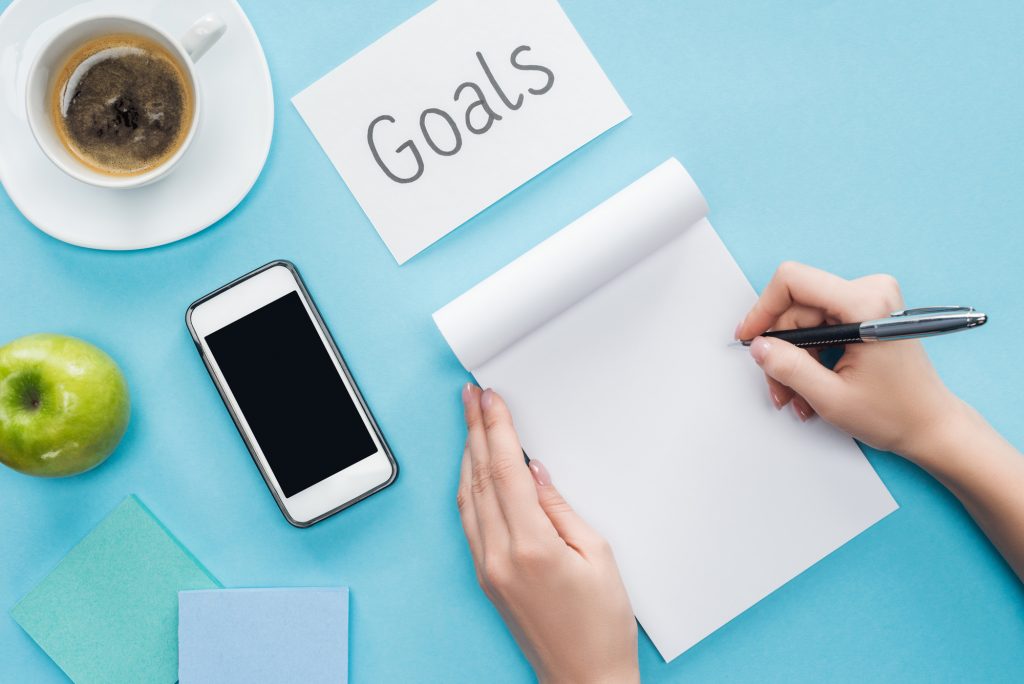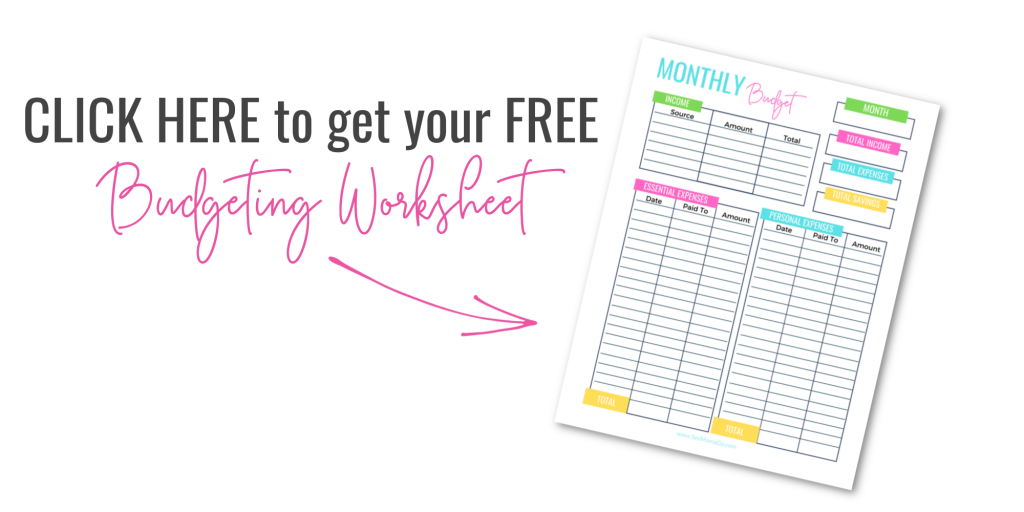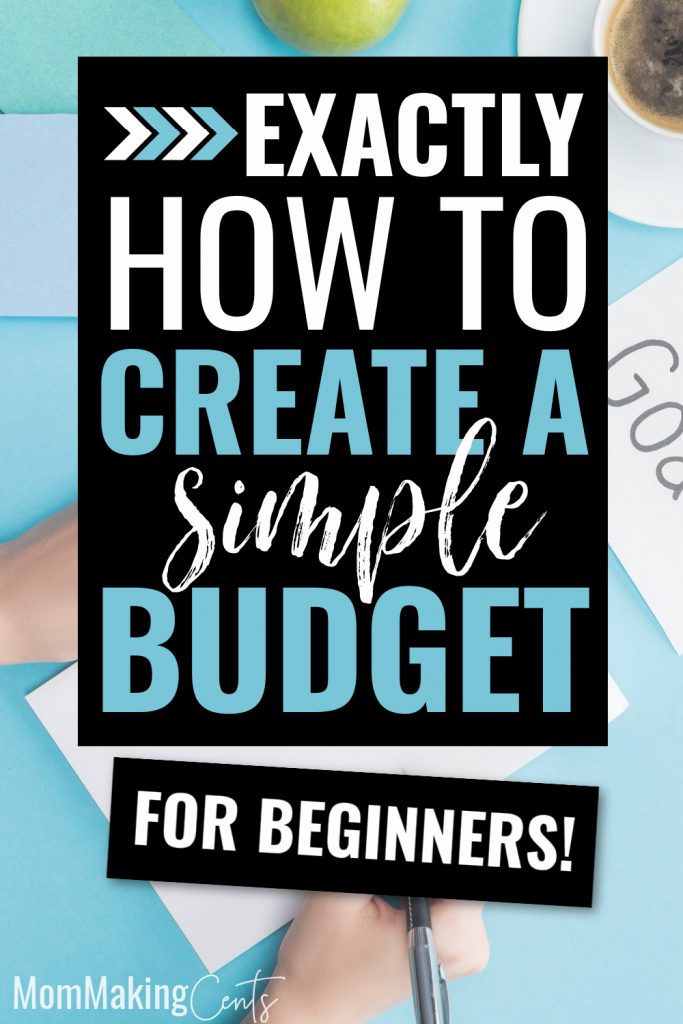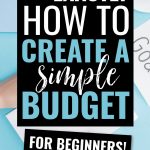You don’t need to know a lot about money to create a budget. With these simple budgeting tips, you can easily save money and build savings.

Everything you need to know about starting a budget + a free monthly budgeting worksheet
Learning how to create a budget is more important than you think!
Adulting sucks. Do you know how I know this? Because I just spent over $2,000 to pay for a plumbing fix. Underground.
Which means all that money goes to something I won’t even see. Not a new phone, not a vacation, not even to my current debt. UNDERGROUND.
Budgets are one of those things that everyone knows they need, but not a lot actually sit down and create one. Or if you create one, how often do you stick to it?

Are you avoiding creating a budget?
I know I avoided creating a budget because I lived paycheck to paycheck for so long. Why create a budget when there isn’t money left over at the end of the month anyway?
You don’t need to worry about what debt to pay off or what gets saved… there’s nothing left after bills anyway!
But thank goodness I did. Because when that quote came out of the Plumber’s mouth, I was able to say “Go ahead, let’s it done”. Instead of crying, screaming, and selling my firstborn child.
No matter how much you make, or what your bills look like, it’s time to sit down and create a budget.
Grab a glass of wine to make it more enjoyable, but just do it already!
What exactly is a budget?
A monthly budget is just a nicely organized way to keep track of all your money.
You keep track of how much money you make and what you spend it on. And then decide what to do if there is any money leftover.
But instead of just ‘keeping track’ of your money, you create a plan at the beginning of every month. So before you even get that paycheck, you know what bills need to be paid and how much money you’ll have leftover to spend or save.
Which really means… will you have enough money to buy that new pair of jeans you’ve had your eye on?
Wouldn’t it be nice to actually KNOW that buying those new jeans is a possibility? Instead of just charging it to a credit card and feeling guilty about it?

Easy Steps to Creating a Basic Budget
Before you even start your new budget, take time to gather all your financial information.
So once you sit down with these budgeting worksheets, you can easily enter all of the information at once.
I also like to take a minute and write down some goals I want to achieve. Are you hoping to save some money? Stop getting into credit card debt? Plan for your future?
Whatever your goals are, write them down. If you can see them and keep looking at them from time to time, it will help keep you focused on why you wanted to start a budget in the first place.
Step 1: Write Down All Your Bills
Start with the fixed monthly expenses you know about. Mortgage/rent, car, insurance, phone, cable, student loans, etc.
*Fixed means things that don’t change. So like your rent or your car payment. They are the same amount every month.
These never change month by month so they are a great starting point to see where the majority of your money goes. It also makes it easy to plan around because you can plan months out, knowing these payments always remain the same.
Next, write down all your variable expenses to the best of your knowledge. Gas, groceries, entertainment, etc.
*Variable expenses are ones that DO change month to month.
Have no idea what you spend on these items? That’s ok, I didn’t either.
Try going a month where you only use your debit card. Even if it’s $2 from a vending machine. Use your debit card!
At the end of the month, you’ll be able to see exactly where your money went and how much.
Step 2: Write Down Your Monthly Income
Write down ALL sources of income. If you only have one job and that’s it, that’s totally ok! Some people have more than one job or other sources of income like child support.
If you are salaried then this is easy. If you work hourly, go based on what your minimum hours worked for the month would be. Leave out any overtime or bonuses.
Write down only what you take home, after taxes and retirement, or anything else that is taken out of your paycheck.
Any additional income such as bonuses and overtime… should not be counted because they are not reliable. Save these for paying off additional debt as they come in.
Step 3: Look at Your Spending Habits
This is the part you may not want to look at, but it’s absolutely necessary.
Go back to the previous month and look at everything you purchased in that month’s time. How much money did you spend on gas? Groceries? Going out to dinner? Buying gifts? Buying new clothes?
If you only pay for things in cash, this might be a little hard to do. But try your best.
Now write down every single little thing you can think of that you spent money last month. This will really show you where your money is going, and what you can start cutting back on.
If you happen to notice that you spent more money at restaurants then you did on your monthly rent… then you KNOW it’s time you started a budget!
Don’t confuse your needs with your wants!
A car payment is a need but any money over the monthly payment is considered a debt reduction (a want). The same goes for credit cards.
While just starting off on a budget, write down only your monthly minimum payments for your credit cards.
If you already pay over the minimum then that’s GREAT! But just for right now, let’s only look at the amount you are required to pay each month.
Ok… continuing on!
Step 4: Stop spending money!
I don’t think we realize it very often, but budgeting and paying off debt can be really easy if we just remember to stop buying things in the first place.
Like, duh, right?
But really, it is that simple.
Budgeting is all about learning how to spend LESS money than the amount you make.
So what comes in every month should always be a higher number than what goes out every month.
One tip I’ve learned is to only use cash for a whole month. Set aside a certain amount and when it’s gone… it’s gone! You force yourself to stop spending money.
When we use credit cards and Debit cards, it’s so easy to just buy whatever we want and think about it later. In fact, we usually don’t think about it until the bill comes and we realize we don’t have enough money to pay it off.
So we pay what we can, and the rest goes onto the next month (along with interest) and we do the same thing the next month.
Before you know it, those small amounts you couldn’t fully pay off start adding up. And that’s how we end up in credit card debt that gets too high for us to ever pay off.
Not a fan of cash?
To be honest, neither am I.
Sometimes I stick my cash in places I forget or I’m really paranoid it’s going to get stolen or lost. So using a debit card is the best thing for me.
I set my alerts on my debit card to warn me when my account gets too low. So as soon as the balance hits under $50, it sends an alert to my phone.
So I know to STOP SPENDING MONEY!
But I also don’t need to worry about losing all my cash. And it actually helps to see my monthly statements and know exactly what I spent all my money on.
Even if it was just a drink at Starbucks I totally forgot about. Whoops.
Step 5: Find ways to cut back.
Once you have your debt figured out, it’s time to start looking at how to tackle it.
This is where the “Debt Payoff” sheet from my free budgeting printable comes in handy.
Write down the debt you have that you want to pay off. Not just the monthly payments you are making, but every detail about all your debt. Including interest rates, interest amounts, monthly minimum payments, and the total debt you still owe.
Give yourself a goal!
Whether it’s paying off a credit card, getting rid of your student loans, or your car payment… have something to work towards.
This is where I highly recommend Dave Ramsey’s Debt Snowball. Take your smallest debt and work towards paying that off. Once that’s paid off, take the next debt + the amount spent on the one just paid off, and pay the next one-off.
Paying off the debt with the highest interest rate will make paying off debt go faster.
But paying off debt that has the lowest amount will help you actually see your debt disappearing and make you feel like you are accomplishing something.
Both methods work fine, just pick the right method for you!
Keep going until every debt is paid off!
If you don’t like using worksheets, check out my tips on the Best Apps You Can Use for Budgeting and Debt Payoff.

Easy ways to have more money every month
If you created your budget and you quickly realized your spending way more money than you are making, then it’s time to start looking at how you can cut back on your expenses.
There are many ways to cut back your monthly expenses.
- Call your utility companies and negotiate your bills. It’s not always easy to do with things like electricity or water. However, you can negotiate cable, internet, and phone services.
- Sell unused items. It’s a great way to not only earn a little extra money but to also clean out your house.
- Cut back on groceries with coupons or money-saving apps.
- Learn how to shop generic. This goes for food AND clothing.
- Learn more about money and budgeting apps that automatically save money for you.
- Rotate your credit card balances to cut your interest: Interest on credit card balances is what keeps us in a debt cycle we just can’t get out of. If you have decent enough credit, find a card with a 0% interest rate for balance transfers. Then, transfer your balance onto that card and keep paying it down until the interest-free period ends. At that point, transfer it back to your original card for another 0% interest-free period. If you keep doing this back and forth every 12-18 months, you’ll essentially never pay interest. Making your credit cards a heck of a lot easier to pay off.
Some ways might be really tough for people to do. We love our comfy lives! But just keep in mind, nothing is permanent.
Once all your debt is paid off, you might have more money every month to bring back your cable or stop shopping generic.
And even go buy those expensive Starbucks lattes again!
Make these a part of the goals you work towards.
Don’t put off until next year what you can start today. Starting a budget today can mean a better year and an easier lifestyle before you know it.
Need More Help on Budgeting?
There are so many ways to pay off debt and save money. Here are some great ideas on how you can stop worrying about money, finally build up your savings, and get out of debt once and for all:
- How To Stop Spending Money You Don’t Have
- Budgeting Categories You’re Probably Forgetting About
- 15 Things To Cut From Your Budget To Save Tons Of Money
What are some of your budgeting tricks? I’d love to hear from you in the comments below!

Pin for later!


Leave a Reply